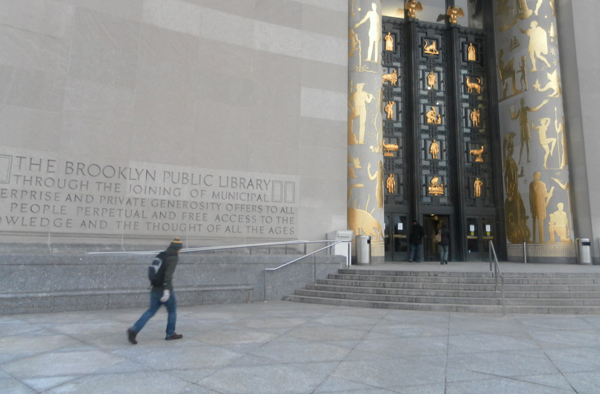
Photo by: Curtis Stephen
In this fiscal year alone, the Brooklyn Public Library has suffered a $1.2 million budget cut. It is now facing a $17.5 million cut in city funding, which would mean the loss of jobs and changes in services.
In a neighborhood full of culture, surrounded by the beauty of the Brooklyn Museum and the Botanic Garden, rests the central branch of the Brooklyn Public Library. Its circular steps and massive entranceway welcome a variety of members of the community. Inside encompasses far more than what one would expect from a neighborhood library: a small cafe sits among the various wings on the first of four levels in the library, and a full-scale passport services center. Still, the traffic of patrons through the lobby area doesn’t properly portray the problems facing the Brooklyn Public Library (BPL).
The Brooklyn Public Library is the fifth-largest library system in the country but has faced decreases in operating hours despite word that some of the borough’s branches are extending their hours of service.
In this fiscal year alone, the Brooklyn Public Library has suffered a $1.2 million budget cut. It is now facing a $17.5 million cut in city funding, which would mean the loss of jobs and changes in services.
Unlike the New York Public Library, the Brooklyn Public Library does not have strong philanthropic support to maintain – or ideally, upgrade – existing resources. As a result, the library has cut back on the purchase of materials, making it difficult to acquire important publications that the public is often looking for. More notably, there has been a hiring freeze for the last four years.
Librarian Ben Gocker, who works at the central Brooklyn Public Library at Grand Army Plaza, has been personally impacted by the financial difficulties. “There’s been a hiring freeze for three to four years now, which is definitely a challenge, especially every summer because of the budget cuts,” Gocker said. “For someone like me, who hasn’t been working here for very long, my job is immediately put in jeopardy, which makes for an anxious workplace.”
Workers’ hours have also been considerably reduced as a result of budget cuts. Part-time reference librarian Shawnta Smith, 28, who also works at the young adult services wing, has been working at the library for three years. “I use to work twenty hours a week. Now I only work three hours a week,” Smith said. “They only keep me because of some sort of moral thing; they’d rather not lose another librarian.”
Retaining librarians is crucial now due to the increasing demand. The recent recession put many people out of work. As a result, they’re turning to their local libraries for resume help, job hunting, and skills training to assist them with finding employment.
Sarah Ball, the job information resource librarian at Marcy Branch Library, leads job classes that are geared toward ex-offenders. She also assists with resume-writing, which she says is in high-demand at the central branch. “Just the other day, a young lady I was helping came in to tell me she got the job she was applying for,” Ball said. “She was so excited and I was happy for her.”
Local libraries are not only vital to those who are unemployed; they’ve long been valuable, community-based institutions in the lives of children too. Marcia Gibson, the neighborhood librarian supervisor at Marcy Branch Library, explains the importance of the library to the youth. “Computers are a big draw for public libraries,” Gibson said. “Kids use to come here to do their homework, but now they come to use the computers. Kids who come to the library are those who may not have computers at home.”
Services such as computers have increased the appeal of the library to young people. The library-lending program, in addition to individual game rooms, allows teens to have access to gaming systems such as Wii and Playstation. It’s just another avenue that the BPL is using to bring local youth through its doors and to maintain its relevance.
Once a place for simply borrowing books, the Brooklyn Public Library has tried to remain relevant by incorporating digital media to its index. Still, the budget cuts have affected the library’s ability to adapt to the digital age as the sale of e-book readers like the popular Nook and Kindle continue to rise. Although e-books are slowly being added to the library’s catalog, the titles are very scarce. “There is a demand for e-books. But with e-books, the titles are limited,” Gocker explains. “There [are] like five e-books for each title and people often wind up having to wait for them.”
Brooklyn Public Library-goers are split on e-books. Some prefer reading the print books already offered. Among them is Anton Sherin, 29, who regularly frequents the central branch. “I don’t like e-books. I like being able to hold a real book in my hand. There’s something about the smell of a book,” he said. “I like the fact that it’s an object that you can hold and not just another electrical charge.” However, others, like Steve Allen would prefer to see more access to digital books. “Yes, I really enjoy them [e-books] mainly because they are easier to carry,” he said.
Part-time reference librarian Roberta Raysor of the central branch contends that the library has found a way to adapt to the changing times. “Both [traditional books and digital notebooks] are used here. I don’t see the conflict,” she said. “E-books are just an alternative way of reading, really just for convenience. Books are the primary source. There will never be a time when books are not being used or read.”
Although the library has an incredible amount of resources, many library-goers are merely using it for recreational purposes, further establishing how important it is for the community. “[The] Brooklyn Public Library has always been a safe zone for me,” says Courtney James, 21. “It’s usually the first place on my list to go when I’m curious and just want to get away.”
As for the future of the Brooklyn Public Library, Gocker believes that librarians will begin to start taking a more active role, becoming content creators, producing and programming, rather than just being a passive reference source for patrons. As for staying relevant, Smith – a librarian – believes the BPL can adapt to a new era without changing its core identity. “I don’t think the library has to ‘stay relevant,’” she argues. “I think the library is the most relevant institution that there is







